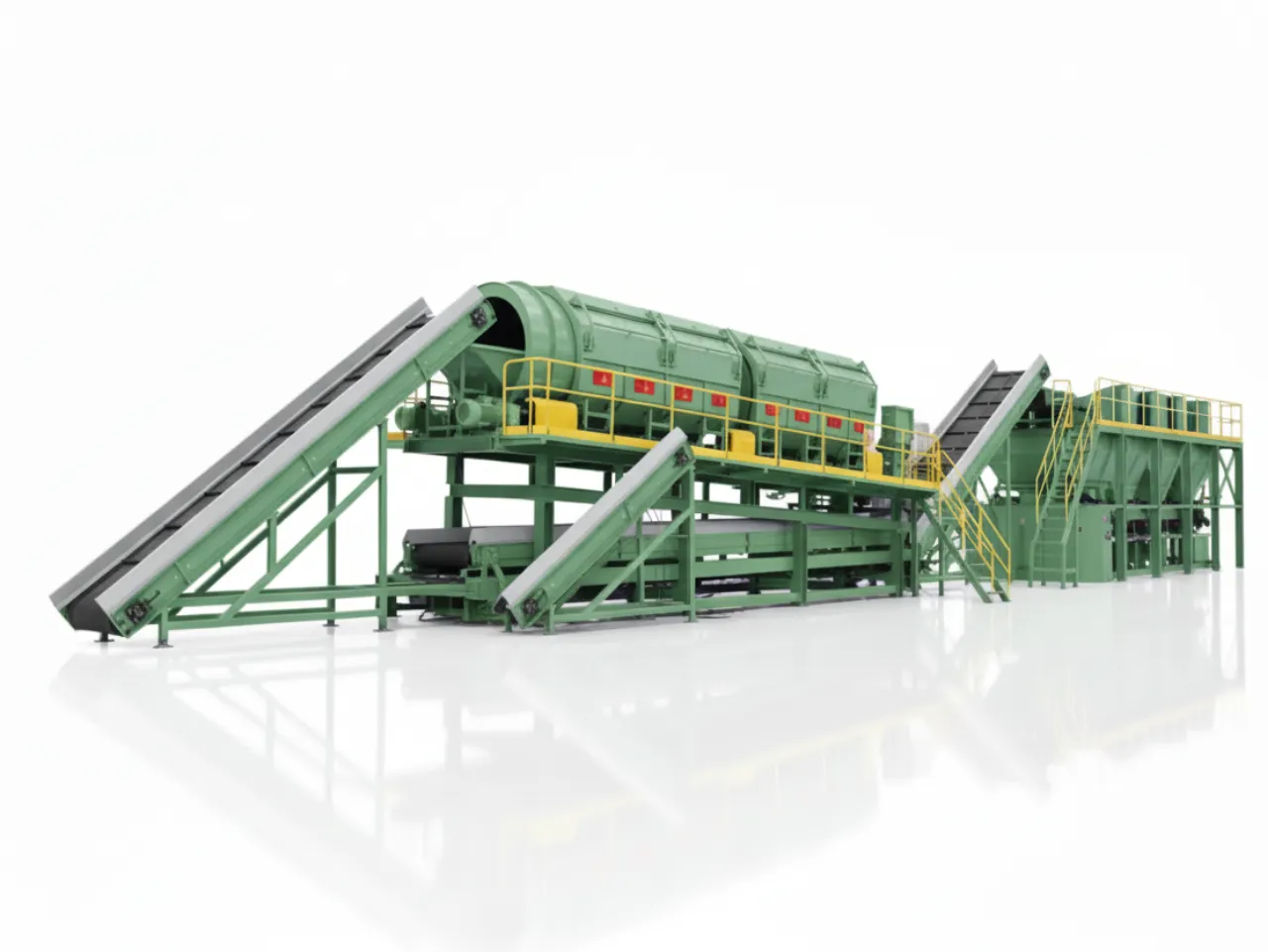Maszyna do sortowania MSW — Automatyczna Linia Sortowania Odpadów Komunalnych
Nasza Maszyna do Sortowania Odpadów Komunalnych przekształca odpady komunalne w czyste, wartościowe produkty. Automatyczne oddzielanie plastików, metali, papieru i organicznych materiałów poprawia wskaźniki odzysku, zmniejsza zależność od składowisk i zwiększa zwrot z inwestycji.
Zapytaj o cenę Maszyny do Sortowania Odpadów KomunalnychZalety Maszyny do Sortowania Odpadów Komunalnych
Dowiedz się, jak Maszyna do Sortowania Odpadów Komunalnych zwiększa odzysk zasobów, obniża koszty utylizacji i przekształca mieszane strumienie odpadów w handlowalne komponenty wysokiej czystości.
Maximize Resource Recovery
Efficiently reclaim valuable materials like metals, plastics, and paper, diverting them from landfills and back into the production cycle.
Generate New Revenue
Create profitable income streams by selling sorted, high-purity recyclables to an ever-growing market demanding sustainable materials.
Reduce Landfill Dependency
Dramatically decrease the volume of waste sent to landfills, reducing disposal fees, conserving land, and minimizing environmental impact.
Promote a Circular Economy
Become a key player in building a sustainable future by transforming waste into raw materials for new products.
Modular & Scalable Design
Our systems are tailored to your specific needs, from small municipalities to large urban centers, with options to upgrade as you grow.
Automated & Robust Operation
Engineered for durability and high throughput, our automated systems minimize manual labor and ensure consistent, reliable performance.
Odzyskane Materiały z Maszyny do Sortowania Odpadów Komunalnych
Zaprojektowana do precyzyjnego oddzielania recyklingowalnych materiałów od mieszanych odpadów komunalnych, dostarczając czyste frakcje gotowe do dalszego recyklingu.
- Mixed Plastics (PET, HDPE)
- Plastic Films
- Paper & Cardboard
- Ferrous Metals (Steel, Iron)
- Non-Ferrous Metals (Aluminum)
- Organic & Compostable Waste
- Glass Containers
- Refuse-Derived Fuel (RDF)
System Sortowania Odpadów Komunalnych: Kluczowe Technologie
Each MSW sorting plant is a synergistic assembly of specialized equipment, meticulously integrated to achieve maximum separation efficiency and purity.
Rozbijacz worków
Efficiently opens bagged waste to expose contents for effective sorting, ensuring no valuable materials are missed.
Ekran trommelowy
Performs initial size separation, removing small organic fines and debris to streamline downstream sorting processes.
Rozdzielacz magnetyczny
Utilizes powerful magnets to automatically pull out and recover all ferrous metals like steel and iron cans.
Separator wiroprądowy
Expertly ejects valuable non-ferrous metals such as aluminum cans, copper, and brass from the waste stream.
Air Separator (Wind Sifter)
Uses controlled air currents to precisely separate light materials (paper, films) from heavier ones (plastics, organics).
Separator balistyczny
Separates waste into 2D (films, paper), 3D (containers, bottles), and fine particle fractions based on physical properties.
Sortownik optyczny
Employs advanced sensors and air jets for high-speed, accurate identification and separation of different plastic types and colors.
Manual Sorting Cabin
Provides a final quality control checkpoint where trained personnel remove contaminants and ensure high purity of recyclables.
Prasa do odpadów
Compacts sorted materials like paper, plastics, and metals into dense bales for efficient storage and cost-effective transport.
Specyfikacje Maszyny do Sortowania Odpadów Komunalnych
Zwykłe zakresy konfiguracji. Ostateczne specyfikacje dostosowywane są do składu Twoich odpadów i celów przerobowych.
| Parametr | Zwykły Zakres | Notatki |
|---|---|---|
| Przepustowość | 10–50 TPH | Zależne od składu odpadów i strategii sortowania |
| Pobór mocy | 150–600 kW | W tym taśmy transportowe, trommel, sortowanie powietrzem i optyczne |
| Operatorzy | 4–12 osób/shift | Dla kontroli jakości i nadzoru |
| Ślad stopy | 1,500–5,000 m² | Konfiguracja modułowa, rozszerzalna |
| Odzyskane Frakcje | Metale, PET/HDPE, Papier, Materiały organiczne, RDF | Konfigurowane zgodnie z wymaganiami rynku lokalnego |
Powiązane urządzenia: przedsortowarki plastikowe • granulatory tworzyw sztucznych
See Our MSW Sorting Plant in Operation
Witness the efficiency and precision of our automated sorting process from start to finish, transforming mixed waste into clean, valuable commodities.
Get a Custom Proposal for Your Project
Contact our engineering team to discuss your specific waste stream composition, throughput requirements, and project goals. We’ll provide detailed specifications, pricing, and lead times.
Często Zadawane Pytania
How does the system handle variations in waste composition?
Our MSW sorting systems are designed for flexibility. The combination of different sorting technologies (trommel, ballistic, air, and optical) allows the plant to adapt to variable waste streams, which can change by season or location. We can calibrate the system to target specific materials based on the typical composition of your incoming waste.
What is the role of manual sorting in a highly automated plant?
While automation handles the bulk of the sorting with high efficiency, manual sorting serves as a crucial Quality Control (QC) step. Trained personnel can spot and remove complex contaminants or mis-sorted items that automated systems might miss, ensuring the final recovered materials meet the high-purity standards required by buyers.
How are different types of plastics (like PET and HDPE) sorted?
The most advanced method used in our plants is Optical Sorting. These machines use near-infrared (NIR) sensors to identify the unique molecular signature of each plastic polymer. Once a specific type of plastic is identified, a high-speed jet of compressed air precisely ejects it from the conveyor belt into the correct collection bin. This allows for fast and accurate separation of various plastics.
What are the primary operational costs to consider?
Beyond the initial investment, ongoing operational costs typically include electricity to power the machinery, routine maintenance (e.g., replacing wear parts, lubrication), and labor for supervision, quality control, and plant management. We design our plants for energy efficiency and ease of maintenance to minimize these long-term costs.



